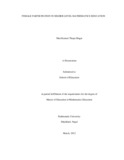
Please use this identifier to cite or link to this item:
https://hdl.handle.net/20.500.14301/214| Title: | FEMALE PARTICIPATION IN HIGHER LEVEL MATHEMATICS EDUCATION |
| Authors: | Magar, Man Kumari Thapa |
| Citation: | Magar,M.K.T.(2012).Female participation in higher level Mathematics education. |
| Issue Date: | May-2012 |
| School: | SOED |
| Department: | DOSE |
| Level: | Masters |
| Program: | Master of Education in Mathematics Education |
| Abstract: | My childhood and college life experiences increased my interest in women higher level mathematics education as I witnessed a lesser number of women and girls students in my classes. In the context of Nepal, women are covering half of the sky (50.05%) but their literacy rate is far lower in comparison to male (Female 42.5% and male, 65.1%, Census, 2001). My experiences and observation of the participation of girls in higher level mathematics education in different universities show that there is a very low participation of girls (around 10%) in the classroom. It also showed that socio-cultural dimensions are the main barriers for girls’ higher mathematics education. So, initially I generated two research questions to identify and understand the causes behind low participation of girls in higher mathematics education. However, these research questions were modified later and which in turn brought about more research questions. I used interpretivism as my research paradigm. The paradigm of interpretivism enabled me to employ emergence as the characteristic feature of my inquiry. So, my research questions were modified many times. Finally four research questions were generated on the basis of socio-cultural dimensions including pedagogical and policy programs factors on girls’ higher education. I used an open-ended in-depth interview to explore the problems and get responses from the participants to understand the problems of low participation of women in higher level mathematics. As I wanted to understand the phenomenon of low participation of women in higher level mathematics, I chose narrative inquiry as my method of research. I interacted with the participants on the basis of the research questions. And with the interaction with them, I came to realize that girls’ participation in higher mathematics education was low. I found socio-cultural dimensions like parental beliefs system, early marriage and public image of mathematics as the root causes for low participation of women and girls in higher mathematics education. Further, lack of proper preparation of girls in mathematical knowledge has made them not to opt for mathematics education in their higher level studies. Moreover, lack of sufficient programs and policies that empower girls in higher mathematics education are other the barriers on girls’ higher mathematics education. |
| URI: | https://hdl.handle.net/20.500.14301/214 |
| Appears in Collections: | Dissertation |
Files in This Item:
| File | Description | Size | Format | |
|---|---|---|---|---|
| manuraju final thesis(March 24th))-1.pdf | 1.1 MB | Adobe PDF |  View/Open |
Items in DSpace are protected by copyright, with all rights reserved, unless otherwise indicated.